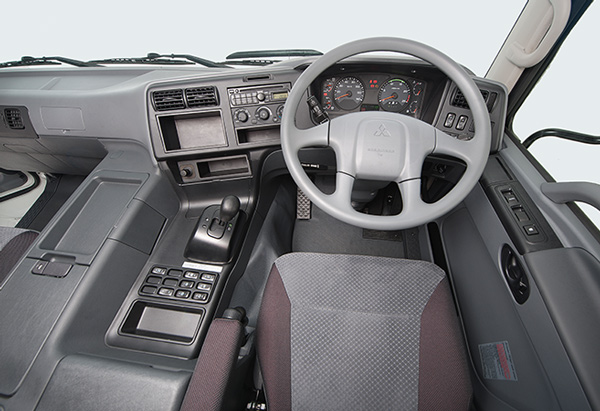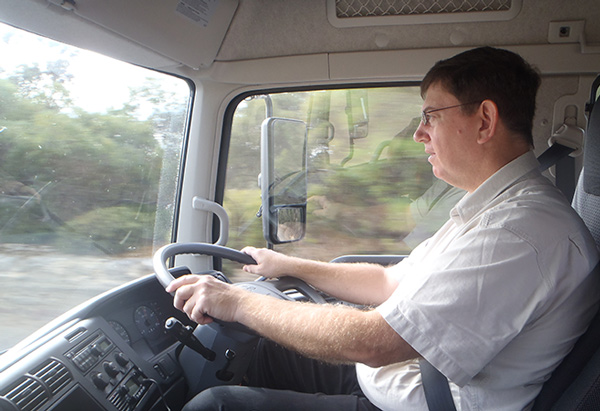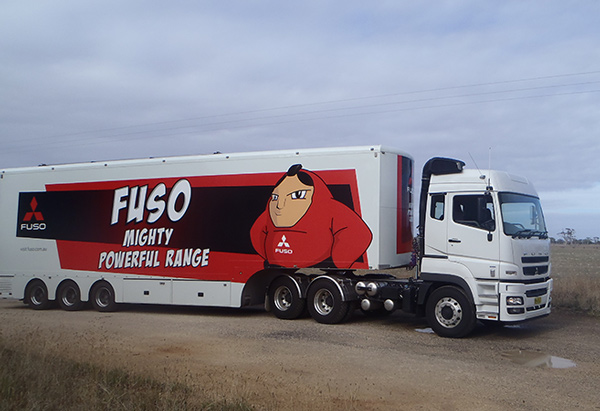The Mitsubishi Fuso Heavy Duty truck is called 'Super Great' in Japan. Gary Worrall drove Fuso’s new prime mover to see if it lives up to the title.
Fuso Trucks is out to change its place in the Australian heavy duty segment with the arrival of its new Heavy Duty model, offering up to 455hp and 53-tonne gross weight, in a bogie drive configuration.
As the song says, ‘everything today makes yesterday slow’, and the update on the Heavy Duty is no exception, with an all-new front that blends traditional Japanese functionality with a slice of European character.
The result is a prime mover that looks like it is here for work, as well as offering plenty of ability under the skin.
The grille is split neatly in half by the raised cabin, which sits higher than the previous version and allows improved cab suspension for a smoother ride across rough roads.
The twin-slat upper grille allows plenty of air to flow over and around the engine, while the lower grille directs cooling air through the radiator fins.
There are also small ‘ears’ above the recessed headlight assemblies to push displaced air around the body and away from the cab steps, keeping them free of mud and slush, which proved vital on a rainy drive between Melbourne and Adelaide.
The upper grille blends outwards into feature lines above the indicators that serve the same purpose for the spotter window set into the door, keeping them free of road grime for better side vision.
The mirrors are Euro-style vertical rectangles with a large rear view mirror over a square spotter mirror on each side, overall rear vision is good, with minimal vibration to blur the image, regardless of the engine speed.
The test truck featured a raised roof for extra headroom, which also creates additional storage spaces inside the cab, although there was no aero kit fitted the higher roof also helped push air up and over the nose of the trailer.
Despite neat aerodynamic touches on the cab design, Fuso perseveres with exposed disc front wheels, although they allow 2,055mm front track for improved ride stability there would also be a penalty in terms of the disturbed air around the wheel wells.
Also lacking is a step up onto the work platform at the rear of the cab, while there is a solid checkerplate floor there are no grab handles or steps.
Instead the driver must negotiate the air tanks, battery box and 40-litre DEF (diesel exhaust fluid) tank on the right-hand side, or the cube-shaped muffler and selective catalytic reduction (SCR) catalyst, none of which offer much in the way of foot or hand holds.
Like all Japanese products, the fit and finish is top shelf, door gaps and panel fit are all even with no entry points for draught or dirt, while the paint quality was excellent.
Engine
Fuso has developed a brand new engine for the Heavy Duty, a 12-litre six cylinder unit that uses SCR rather than SCR of the ADR 80/02 version.
While requiring a new exhaust system, to include the catalytic converter, and the associated AdBlue tank and dosing hardware, the big advantage is the lower operating temperature allowed a smaller radiator than previously, with corresponding improvements in engine bay airflow.
Also bucking the trend is the use of a waste-gated turbo, rather than the variable geometry units used on most other trucks, with the engine tuned to deliver peak torque of 2,200Nm at just 1,100rpm, with a slight drop-off to 1,600rpm before the 335kW of power arrives at 1,900rpm.
Transmission
The Heavy Duty is offered with the excellent Inomat-II automated manual transmission (AMT) that debuted in the previous generation Actros as the PowerShift, with all the advantages of a fly-by-wire transmission.
Unlike the Benz installation, the gearshift looks exactly like the Canter mechanism, helping normalise the computer-controlled shift for drivers migrating from a traditional three-pedal manual transmission.
Cab and Controls
The Euro-Asian blend continues inside the cab, with a wide vinyl and plastic-trimmed dash that cocoons the driver, meaning all vehicle controls fall easily to hand.
The steering wheel is traditional Fuso, a thick-rimmed, large diameter, four-spoke vinyl-wrapped unit that is easy to grip, while the wide door trim doubles as an armrest, with a fold down unit on the left providing a comfortable long-distance driving position.
The seat itself is comfortable, with mechanical suspension damping out any tremors that make it past the cabin’s air suspension, however, the lack of an integrated seatbelt meant any large seat movements saw the driver ‘coat hanger-ed’ by the B-pillar-mounted belt.
With the majority of its competition offering seats with integrated belts, this should be high on Fuso’s agenda of items that can be fitted locally, along with a Bluetooth-compatible audio unit, particularly given the safety focus of Fuso parent Daimler.
Instead, individual dealers offer their own Bluetooth audio option and, while effective, it can cause differences in specification between fleets, rather than a factory unit that is fitted to all trucks.
This aside, the dash layout is sensible and easy to read, with a combination of analogue gauges and a colour information display with fuel consumption, service indicators, hour meter, tripmeter and oil level check.
Initially, the push-button sequence felt complex, but a few hours into the journey and switching between screens became second nature.
Similarly, the minor control panel to the driver’s left, behind the gear selector, took a couple of hundred kilometres to feel natural. However, by the time we reached Adelaide it was simple to change functions by touch alone.
The other major controls are the two stalks on the steering column, for indicators, wipers, cruise control and the Powertard multi-stage exhaust brake.
The internal panel fit of the cab is as good as the exterior, with high grade plastics and vinyls used in concert with comfortable fabric seat covering, while 900km on the road did not reveal a single draught, despite outside temperatures of around 10C for the whole journey.
Performance
As I drove from Melbourne to Adelaide in the new Fuso Heavy Duty, I reflected on the new engine designed for this truck.
The resulting design is a flexible and hardworking unit that is happy to pull from just 1,000rpm, through to 2,000rpm, with 100km/h arriving at 1,400rpm in top gear despite the 4.6:1 final drive.
The downside is the Japanese insistence on small fuel tanks. While 400 litres is plenty for the Honshu Express, in Australia it required two fuel stops between Melbourne and Adelaide.
To compete in this segment, Fuso must look at a local alternative, at least 600 litres will be the ‘get-in’ capacity for Australian inter-urban single trailer operations, offering a working range of at least 1,000km.
The Heavy Duty underlines the improvement in driver comfort offered by AMT, which replace the mechanical connection between the driveline and the cab with vibration-free electronics.
The end result is a ride that borders on the car-like, with virtually no engine or road noise in the cabin, so that conversations, with yourself or others, are crystal clear and fatigue is virtually eliminated.
The Heavy Duty is so quiet inside that there was lengthy discussion about tuning the radio aerials on the mirror cluster to see if they could hold a tune.
While nothing replaces a good sleep, the driver is less fatigued after steering the Heavy Duty than a similar stint in a truck fitted with a traditional manual.
This is not to say the Inomat-II is perfect, but it eliminates the peripheral jobs and allows the driver to focus on the bigger problems of merging traffic, stop lights and oncoming vehicles.
The other advantage is the ease of gear shifts. A quick pull back on the shifter is all that is needed to drop a cog, while a push forward goes up a gear, with the computers handling double clutching and engine blipping to ensure a smooth change.
And with the retirement rate of experienced drivers, that is going to be a big issue for fleets in the future, to have equipment that can be driven efficiently by all drivers, not just a small group.
The driver still needs to be aware of road and engine speed, to ensure good average speed is maintained, but with the electronics taking care of the shifting the driver can choose the best time to drop a gear to maintain momentum without sacrificing fuel economy.
Similarly on downhill runs, the truck cannot see or feel how steep the road is, so the driver can intervene early to ensure they are always in control by manually slowing the truck and selecting low gears for safe descents.
The Heavy Duty uses a combination of long tapering leaf and six-rod steel suspension, with the cab sitting on airbags to absorb any wayward shocks travelling up from the road.
The result is a comfortable ride. While big hits, such as the road between Horsham and Naracoorte, with dips large enough to hide a small car, will always make themselves felt, the smaller lumps and bumps are rendered invisible.
Even corrugated sections of road could barely be felt through the floor of the cab, although the steering retains a good feel for the road, so the driver is aware of what is happening, without having the fillings shaken from their teeth.
Despite these good qualities, the steering felt excessively light, with plenty of free play in the steering up to 60km/h, although it tightens up above this speed and is ideal for high speed cruising.
There is also a lot of free play around the straight ahead position, so that at lower speeds there is a constant feel of oversteer that makes it difficult to choose and hold a line without correction.
While the majority of the run through western Victoria and into South Australia is relatively flat, the Powertard exhaust brake got a solid workout on the run down through the Adelaide Hills, which finished at a set of traffic lights after an extended steep decline.
When used with the cruise control, the exhaust brake will automatically engage if the truck exceeds the set speed, such as on a long gentle slope, with higher levels of retardation applied if the speed does not reduce.
In the third and fourth stages, the transmission will automatically downshift for higher engine revs to provide maximum engine braking, while the driver is able to intervene at any time via the service brakes or by downshifting to hold a lower gear for steep drops.
Dropping down the hills into Adelaide, we manually locked the transmission into seventh gear and applied full Powertard retardation, and held the speed at 30km/h, prompting a reduction in engine brake by one level, which still comfortably braked the single trailer combination without turning into a mobile chicane for other drivers.
Verdict
The Benz influence on Fuso is easy to spot on the new Heavy Duty. Not just the lines but the sophistication of the driveline shows a strong European bloodline, without losing the inherent Fuso-ness of the brand.
While issues such as the need for a standard Bluetooth unit can be overcome, the biggest stumbling block will definitely be fuel capacity; it is hard to see too many fleets signing on for an otherwise excellent truck if drivers are stopping two or three times per shift to refuel.
Likes:
- Driver comfort levels outstanding
- No road noise
- Smooth and precise shifting of Inomat gearbox
- Flexible and torquey engine
Dislikes:
- Pillar-mounted seatbelt does not move with seat
- No factory Bluetooth
- Needs more fuel capacity
Specifications
Make/Model: Fuso Heavy Duty
Configuration: 6×4 Prime Mover
GVM/GCM: 25,400kg/53,000kg
Engine: Fuso OM 457 12-litre inline six cylinder, waste-gate turbo, air-to-air intercooler, electronically controlled unit pump injection
Emission Control: Euro 5 with SCR
Outputs: 335kw @ 1,900rpm/2,200Nm @ 1,100rpm
Fuel Tank: 400 litres
DEF Tank: 40 litres
Transmission: Inomat-II 12-speed automated manual with computer controlled clutch
Brakes: Full air system, drum brakes on all axles, with ABS and ASR (anti-skid regulator)







